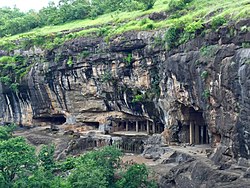| Pitalkhora Caves | |
|---|---|
 Overview of Pitalkhora caves. | |
| Coordinates | 20°18′49″N74°59′39″E / 20.313473°N 74.994228°E |
| Geology | Basalt |
The Pitalkhora Caves, in the Satmala range of the Western Ghats of Maharashtra, India, are an ancient Buddhist site consisting of 14 rock-cut cave monuments which date back to the third century BCE, making them one of the earliest examples of rock-cut architecture in India. Located about 40 kilometers from Ellora, the site is reached by a steep climb down a flight of concrete stairs, past a waterfall next to the caves. [1]









